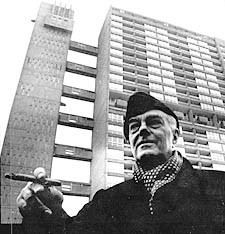Nationality Hungarian Name Erno Goldfinger Books British Furniture Today | Occupation Architect Role Architect | |
Buildings 2 Willow RoadAlexander Fleming HouseBalfron TowerCarradale HouseTrellick Tower Died November 15, 1987, London, United Kingdom Education Ecole nationale superieure des Beaux-Arts Structures | ||
Short film balfron tower london video 1960 s brutalist erno goldfinger block architecture
Ernő Goldfinger RA (11 September 1902 – 15 November 1987) was a Hungarian-born architect and designer of furniture. He moved to the United Kingdom in the 1930s, and became a key member of the Modernist architectural movement. He is most prominently remembered for designing residential tower blocks, some of which are now listed buildings.
Contents
- Short film balfron tower london video 1960 s brutalist erno goldfinger block architecture
- Trellick tower brutalist style by architect ern goldfinger slideshow
- Biography
- Modernist in London
- Post World War II
- Rise of the high rise
- Personal life
- Legacy
- Buildings
- References

Trellick tower brutalist style by architect ern goldfinger slideshow
Biography

Goldfinger was born in Budapest to a Jewish family. The family business was forestry and saw-mills, which led Goldfinger to consider a career in engineering until he became interested in architecture after reading Hermann Muthesius's Das englische Haus, a description of English domestic architecture around the turn of the twentieth century. He continued to recommend the book for most of his life.

Goldfinger moved to Paris in 1921, after the defeat and collapse of the Austro-Hungarian Empire. In 1923 he went to study at the École nationale supérieure des beaux arts in the atelier of Léon Jaussely, and in the following years got to know many other Paris-based architects, including Auguste Perret, Mies van der Rohe and Le Corbusier. In 1929, before finishing his studies, Goldfinger established a partnership and worked on a number of interior designs and an extension to a holiday home at Le Touquet.

He was strongly influenced by the publication of Le Corbusier's Vers une architecture, and became a fervent admirer of Le Corbusier's former mentor, Auguste Perret, an expert in designing reinforced concrete structures and an inspiration for Goldfinger when designing his own home. In the early 1930s Goldfinger met and married Ursula Blackwell, heiress to the Crosse & Blackwell fortune. The remainder of his career would be based in the UK.
Modernist in London

In 1934, Ernő and Ursula Goldfinger moved to a flat in Highpoint I, London. Before World War II, Goldfinger built three houses (including his own) at 1–3 Willow Road in Hampstead, North London, and another at Broxted, Essex. His own house, 2 Willow Road, is now in the care of the National Trust.
Post World War II

After the war, Goldfinger was commissioned to build new offices for the Daily Worker newspaper and the headquarters of the British Communist Party. He also built Alexander Fleming House in south-east London for the Ministry of Health. In the 1950s, he designed two London primary schools from prefabricated pre-cast concrete with brick infill for the London County Council in Putney. One of these buildings was damaged and then demolished by a rogue developer who was prosecuted in 2008.
Rise of the high rise
In an attempt to solve the huge shortage of housing in the country following World War II, in which nearly 4 million houses had been destroyed or damaged, the British Government began to see high-rise buildings as a solution, and Goldfinger rose to prominence in England as a designer of tower blocks.
Among his most notable buildings of the period were the 27-floor Balfron Tower and the adjacent eleven-storey Carradale House in the East End London Borough of Tower Hamlets, which served as models for the similar 31-floor Trellick Tower in North Kensington (started 1968, completed 1972). These three are notable examples of Brutalist architecture.
Personal life
Goldfinger was known as a humourless man given to notorious rages. He sometimes fired his assistants if they were inappropriately jocular, and once forcibly ejected two prospective clients for imposing restrictions on his design.
A discussion about Ernő with Ursula, Goldfinger's cousin, on a golf course prompted Ian Fleming to name the James Bond adversary and villain Auric Goldfinger after Ernő (Fleming had previously been among the objectors to the pre-war demolition of the cottages in Hampstead that were removed to make way for Goldfinger's house at 2 Willow Road). Goldfinger consulted his lawyers when Goldfinger was published in 1959, which prompted Fleming to threaten to rename the character 'Goldprick', but eventually decided not to sue; Fleming's publishers agreed to pay his costs and gave him six free copies of the book.
Goldfinger died on 15 November 1987, at the age of 85, and was cremated at the Golders Green Crematorium where his ashes remain.
Legacy
Although Goldfinger enjoyed living in his own buildings, they were unpopular among both the public and many post-modernist architects. Towards the end of the 20th century Goldfinger's work became more appreciated. Trellick Tower is now a Grade II* listed building and has become something of a design icon, appearing on T-shirts, paintings and in the lyrics of the song For Tomorrow by Blur. The few privately owned flats within fetch high prices at sale. Balfron Tower and Carradale House are also listed Grade II, while an adjacent building by Goldfinger's studio, the 14-storey Glenkerry House, is run as a housing co-operative and is regarded as a model for management of buildings of the type.
In 2000, Ernő Goldfinger's estate endowed a sum of money to foster links between Hungary and the United Kingdom by sponsoring young Hungarian architectural students to study, travel or work in the UK. Their intention was to honour Ernő's achievements, his commitment to his profession, and his lifelong support for his compatriots. The RIBA Goldfinger Travel Scholarships have been awarded since 2002.
